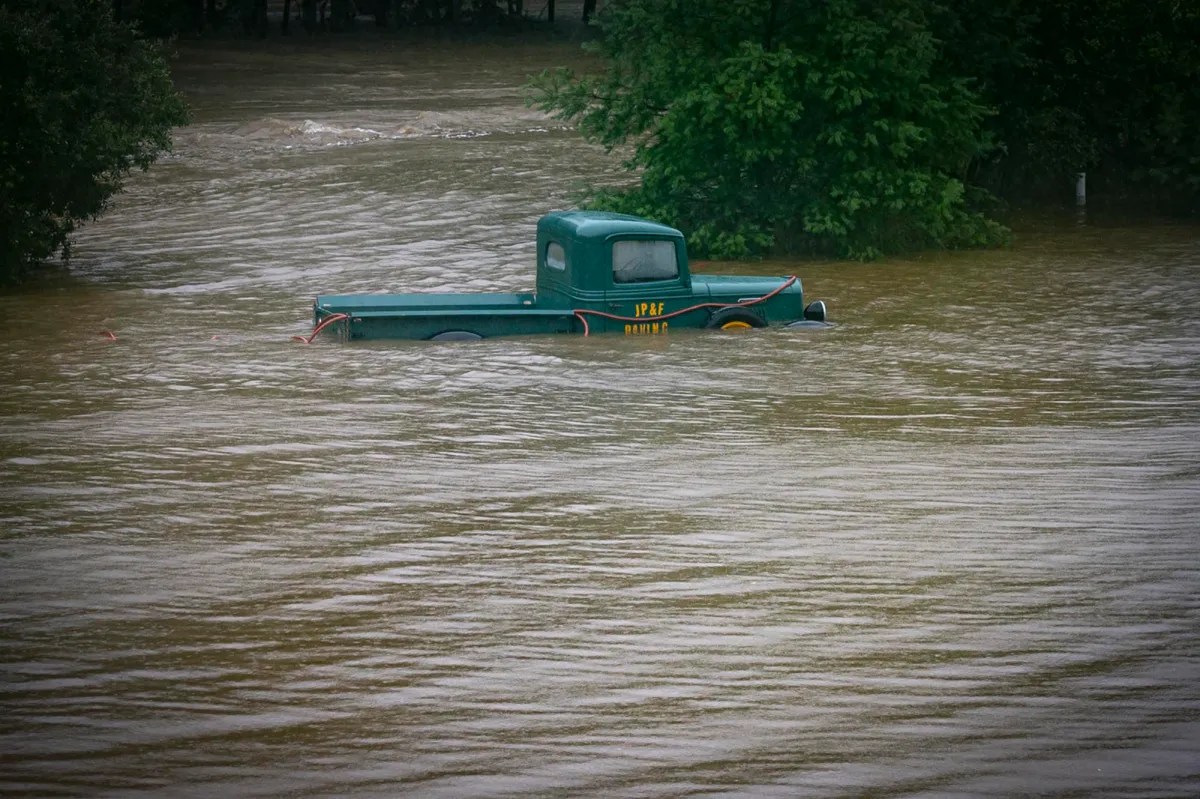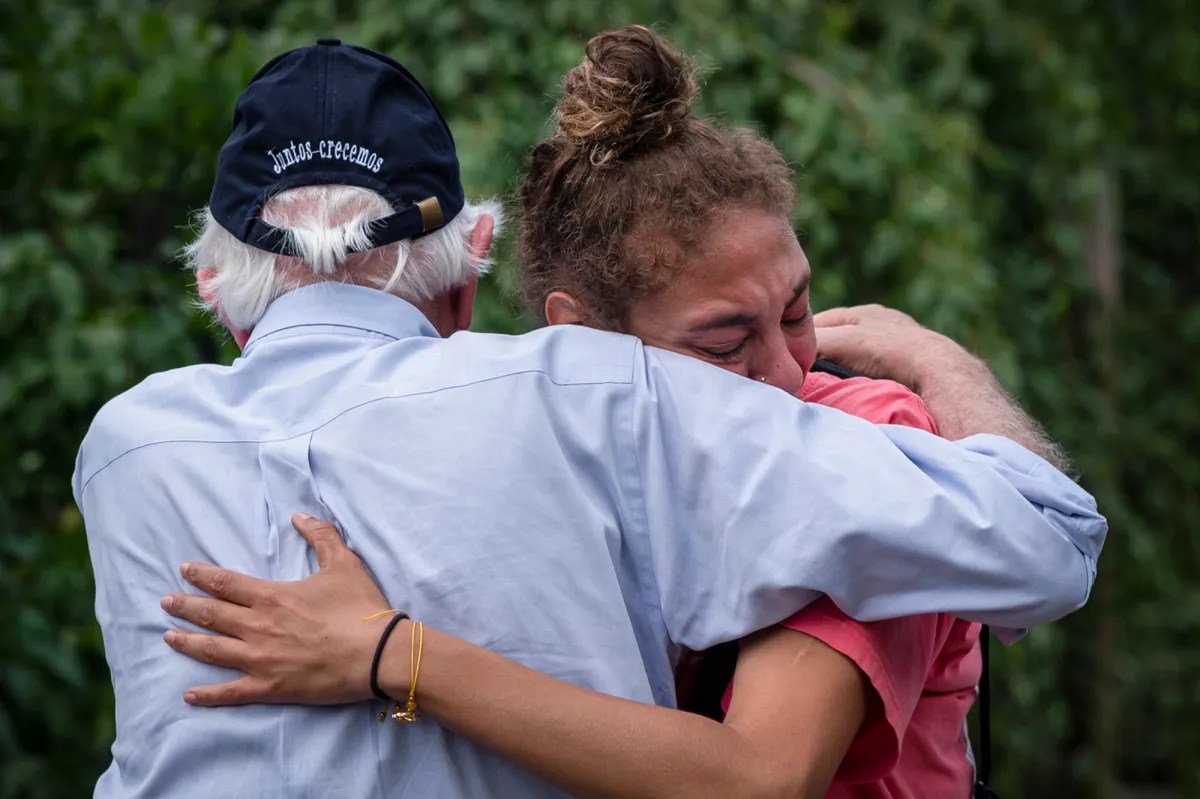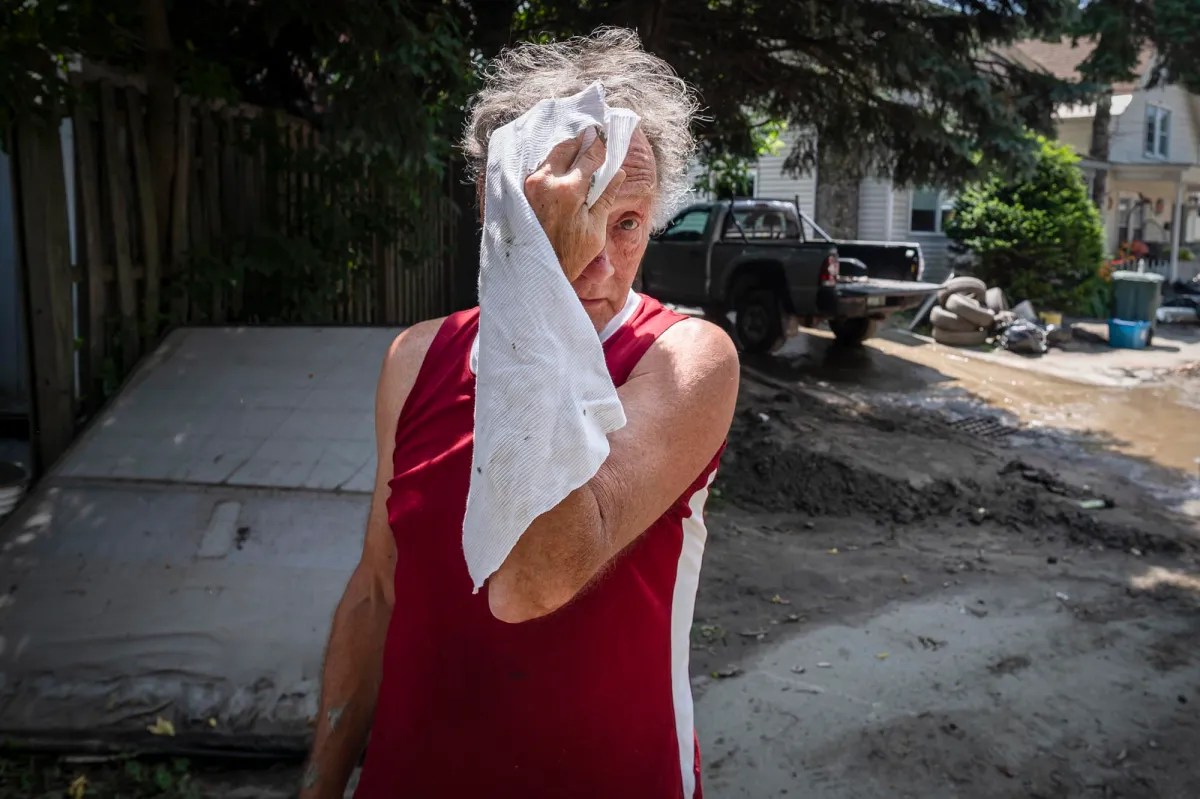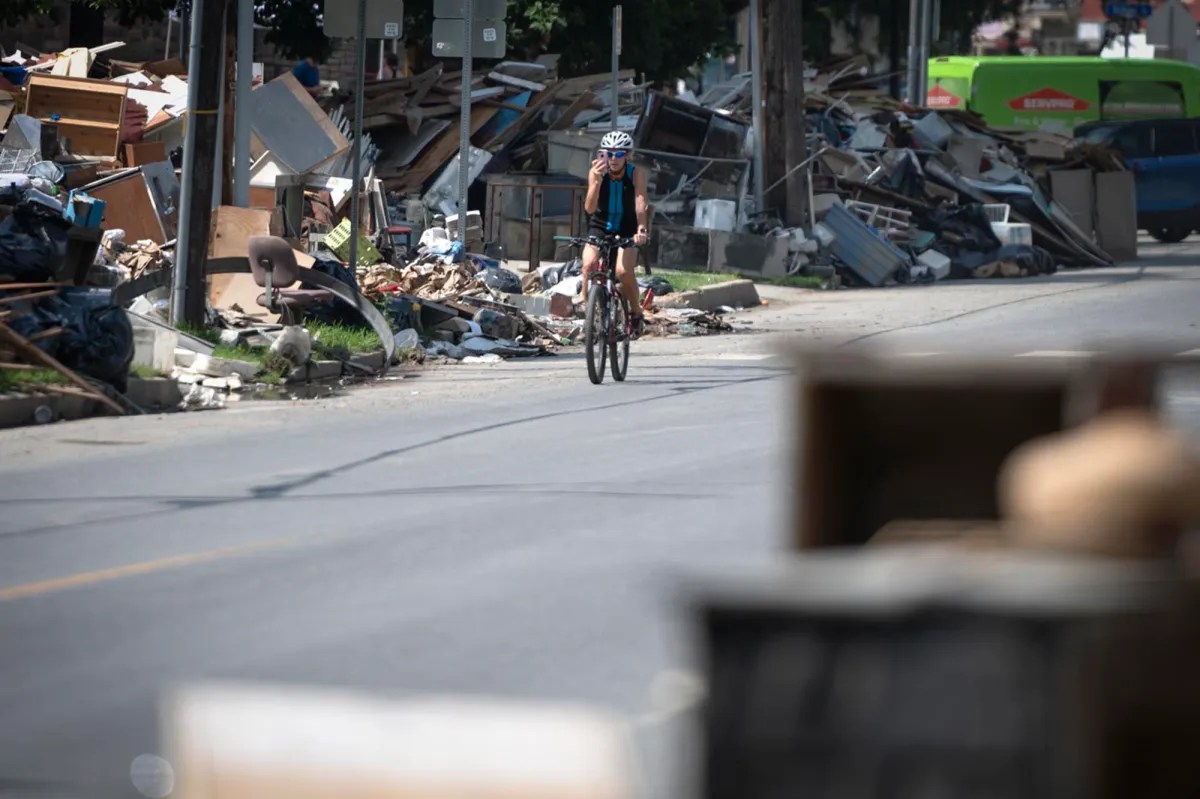
The Deeper Dig is a biweekly podcast from the VTDigger newsroom, hosted and produced by Sam Gale Rosen. Listen below, and subscribe on Apple Podcasts, Google Play, Spotify or anywhere you listen to podcasts.
Early this month, heavy rains led to historic flooding in many parts of Vermont, causing massive — as yet uncounted — damage to homes, businesses and infrastructure. At the time of this recording, the state has confirmed that one person was killed by the floods.
Like in Tropical Storm Irene in 2011, many towns were under feet of water, and some were transformed into islands, with routes in and out cut off by floodwaters and damaged roads.
Against this backdrop, reporters and photographers from VTDigger fanned out, reporting from as many of the affected areas as they could reach. Today, we’ll hear from a few of them about what they found.
Below is a partial transcript, edited for length and clarity.
Sam Gale Rosen: First, let’s hear from Erin Petenko.
Erin Petenko: I’m Erin, I am a reporter at VTDigger. I usually cover data reporting. I make charts and graphics for the website. But I also happen to live in Montpelier. So I was very involved with the Montpelier coverage during the recent flood.
Sam: I asked Erin about her experience of the floods. You’ll hear a few time references — this conversation took place on July 18, about a week after the height of the flooding.
Erin: This is quite a tale. I think I first learned about the floods when I received a notification from our beloved editor-in-chief Paul Heintz on Sunday saying, hey, there’s going to be a lot of flooding.
And I was actually in Massachusetts at the time. So I was like: OK, well, maybe I’ll just drive home a little bit earlier. I think I knew intellectually that it was going to be bad. But you know how sometimes there’s a divide between knowing something as a fact and knowing something emotionally, like processing how bad it’s going to be. By Monday — I think the first time it really sunk in was, I decided to walk to Shaw’s just to grab a spare gallon of water, just in case, you know, in case the water goes out for a day. And I got out of the grocery store, and I looked over at the Winooski River, which is right next to the Shaw’s, and it was like nothing I had ever seen before at that river or anywhere else. It was roaring. It was boiling almost with all of the strength of the waves and the water. And it was a really, really ugly brownish color. You know, it was nothing like the Winooski River that I knew and loved. And I was like, wow, OK, maybe this really is going to be bad.
The first time I saw the floodwaters start to pass into, you know, places where it’s not supposed to be is probably around 7 p.m. on Monday. I looked over and I saw that Elm Street had actually started to have floodwaters. And I also looked over and realized there were firefighters at the little intersection of Elm (Street) and School Street, just kind of standing there figuring out what to do. I mean, there were a lot of people who were still trying to get home frantically. You know, it wasn’t too bad at that point. But it was still raining, right? Eventually, you know, I turned in for the night.
When I woke up, School Street Bridge was underwater. Elm Street was underwater. You couldn’t walk like 2 feet into it. And, when I walked by the State Capitol, you know, you could see the waters not just flooding State Street, but also running down State Street like it had become part of the river. Like that was the Winooski River at that point. It was just flowing down State Street. It was this very light brownish color, not like any color that water is supposed to be in Vermont. It smelled like gasoline. It was bubbling up in really weird ways and really weird places, probably because of the storm drains and how it was flowing around storm drains, and all the other things that were probably hidden under the waters because I couldn’t see into them at all. They were completely opaque. And then, you know, occasionally you would look over and you’d say like, is that a car poking out of the top of the floodwaters?

And, you know, people were just congregating at the edge where the floodwaters were heightened and kind of just staring. I think people were kind of in shock at that point. I was in shock at that point. Just kind of going, what is this? Like, your brain cannot process that this is your hometown and that it’s just completely covered in floodwaters.
And, you know, I was just standing there thinking, Oh my God, Bear Pond Books is underwater. Oh my God, Wilaiwans’s in Montpelier — best Thai restaurant in the state — is underwater. Like just all these places that I go to on a regular basis and just like realizing that all of them are going to be destroyed.
And then, of course, you know, around the same time, we were starting to hear reports that the Wrightsville Dam was potentially going to spill over. There were some reports it was going to breach — but that’s not actually true. That dam was never in danger of actually collapsing or losing structural integrity. The question was whether the level of the reservoir would go over the top of the auxiliary spillway. And because it’s just so much water in that reservoir, it would have increased the level of flooding in downtown. Ultimately, it came within a foot.
From what I understand, they had someone standing at the top of the dam and just watching it, you know, ready to alert the town if it was to go over the top of the spillway. Of course. I was constantly getting messages and phone calls telling me like: I heard it’s going to spill over. I think that a lot of people were just really, really nervous. You know, things were flying around.
I did get in touch with the fire chief and he was like: It’s OK. It’s not going over. It’s not going over. I talked to the dam guy like 20 minutes ago. And indeed, you know, 20 minutes later, when the waters would have reached Montpelier, it was the same as it was. So it was really touch and go for a while, but, you know, obviously a relief to see that it didn’t eventually happen. And then sometime around 3 p.m., there was a noticeable change in the water levels, like you can see the edge of where they had reached because it left this big muddy footprint where it actually was at that point.
And people were kind of slowly starting to try to get towards their businesses to check on how their businesses were doing. I think I actually passed one woman in particular who was trying to wade through the floodwaters. And she was like, I can get a little bit further this time! And then she turned around and was like: I can’t go all the way, but, you know, of course wait a couple more hours.
And then, you know, you wake up the next day, and the floodwaters have kind of receded. But it definitely does not look normal downtown. There’s just muck, like a layer of muck over the entire city. And, you know, that’s when people started to kind of jump in and start to do basic, like: What does my business look like? What does my property look like?

You know, people were starting to coordinate volunteer efforts. I think it really got going the next day. Volunteers have just arrived in Montpelier in droves in recent days to help businesses basically just clear out all the stuff that got damaged in the flood. I mean, you walk down Montpelier right now on Main or State (streets), and there’s piles of debris that are bigger than my head, just full of every single bit of equipment that businesses have. I saw pieces of furniture, I saw random spots of inventory, like shoes or books or bookcases, the entire bookcases had to be thrown out with the books. And, you know, pieces of drywall, pieces of the actual composition of the rooms themselves had to be thrown away as well. So those are still kind of piling the streets. I think that trash pickup is ongoing.
Montpelier has started a fundraising effort through the Montpelier Strong Recovery Fund to try to help businesses and possibly some other organizations that were damaged during the storm. We don’t know yet the full extent of how many businesses were damaged. As of yesterday morning, Monday (July 17) morning, there were a handful of businesses open on Main (Street), like the Skinny Pancake, Buddy’s is open. Shaw’s is open somehow. I mean, it’s right by the river. I don’t know how that works. But pretty much every business that I walk by is closed right now. So I would guess that it’s a pretty pretty high percentage of Montpelier businesses. Right now, the fund has raised about $250,000. They are hoping to raise far more because some businesses reported losses of over $1 million in inventory, is what the fundraisers are saying.
There are programs like the Small Business Administration loans that businesses can apply for. But like I said, it’s a loan. So it’s not necessarily as advantageous for businesses that are already struggling, as you would get if you were just getting a grant. And, you know, the other aspect of that is just the immediacy of it. A lot of businesses really want money right now, you know, the owners need to pay their business expenses, and they also need to pay their own bills. Maybe they need to pay rent on their own apartments, for example. So they are really hoping to do that sooner rather than later.
Sam: In addition to her reporting, Erin took care of VTDigger political reporter Lola Duffort’s cat.
Erin: Yes, yes. So during this experience, one of my coworkers, Lola, had to evacuate her apartment, mostly to avoid that spillway that threatened to run over. And she found someone to take her in that couldn’t take in her cat, Djuna, because they had two cats already. This is actually my other coworker, Sarah. So Djuna came and stayed with me and my husband and my cat. They did not get along, of course, but they looked at each other through the door and hissed at each other. And that was the extent of the fighting. Djuna wasn’t happy to be stuck in my husband’s office. But my husband did keep her lots of company. And you know, I kept coming to check out her and give her some extra pets and love. And she was happy about that. So she’s all right. She got returned to her human after two nights. And last time I saw her she was doing just fine.

Sam: I also spoke to Ethan Weinstein, VTDigger’s southeastern Vermont reporter. He covered some of the areas that were hit by the storm’s highest total rainfalls, including Ludlow, which was cut off by the closing of Route 103, the main artery in and out of town.
Ethan Weinstein: I think that for the first couple days, I was definitely fueled by adrenaline. It was an experience unlike any I’d had where essentially stories were just everywhere. I would drive until something prevented me, whether that was a river over a road or a broken bridge or, you know, a swelling stream that looked a little too scary to cross. And then I would just start talking to people and snapping photos. And yeah, it was like there were stories everywhere because there seemed to be scary things going on everywhere.
Sam: And how did you actually end up getting to Ludlow?
Ethan: So I didn’t get to Ludlow until Tuesday. So on Tuesday, I headed down Route 103, around Proctorsville, Cavendish, and headed as far as I could get into Ludlow, eventually there was a pothole that seemed to have been exacerbated by the flooding and was quite deep and although I saw some trucks going through it, in my sedan I didn’t quite feel comfortable. So I left my car and started walking into town.
Sam: And what did you see as you went in?
Ethan: I mean, the damage was everywhere. There were porches that had been knocked off of businesses there. One of the businesses that had flooded was a company that sells hot tubs and jacuzzis. And so, along the river, there were hot tubs that had been washed downstream. And some of them had been brought back to the business and were sitting there partially destroyed. Roads were covered in mud where the rivers had flown over them. You know, people were pumping water out of basements and out of first floors. In some places, asphalt had just erupted seemingly. And there were a lot of impassable roads. Th ere were cars that were sort of surrounded by rocks that had been pushed by the river. Eventually, as I was walking towards the center of town, I got to the Black River Mobile Home Court, a mobile home park in Ludlow that was particularly damaged by the flooding.
Sam: What kind of damage did you see there?
Ethan: Well, on Tuesday morning, there was still water pooled all throughout the park. The Black River flows right behind the mobile homes, and so it didn’t have very far to go. In some places, there were cars that had been left in the park and were no longer usable. There were propane tanks that had been pushed around by the flooding, lawn furniture, porches ripped off. I mean, it was a real mess. And the most significant damage I saw there was a mobile home that had been pushed about 100 yards downstream and wound up getting wedged sort of askew into some trees downstream.

Sam: And did you see any of the people who lived there and how they were dealing with all this at the time?
Ethan: Yeah, I got to chat with a few of the folks who live in the park. And was honestly sort of surprised by their positivity. I think they were still in shock. As was, you know, everyone around there and so they were really able to find silver linings. One guy and his wife that I chatted with there, they’d lived in the park during Irene, and Irene had completely destroyed their home. And so this guy, he was a builder, and he said that after Irene he completely redid the trailer. He raised it 16 inches to try to prevent future flooding, and so he poured thousands of dollars into the home. And ultimately, despite his efforts, the home did flood on Monday, but it only flooded about an inch, and he thought that he’d have to redo the floors, but everything else was salvageable. And he actually moved his cars to higher ground. So he didn’t he didn’t lose that, and he was feeling quite good about the day’s events. He’d slept at a shelter across the street and was grateful for the volunteers that had food and beds and all of that. And he had quite a positive outlook.
I spoke to another woman who had only recently moved to the park and had put in a lot of renovations in her trailer. I think she said $30,000 worth. And much of the outside of her trailer had been destroyed by the flooding. Thankfully, very little water had entered her home. And so you know, she would need to redo part of the outside but because of where it was situated within the park, it wasn’t a total loss. But the whole park was evacuated, and she’d been carried out by a firefighter as water was rushing through the park. And at that point, obviously, you know, she had very little time to think about what she was going to bring with her. And she didn’t take her car, and so she thought her car was totaled. It was still sitting there in the park on Tuesday.
Sam: And you saw some examples of people who live there helping others too, right?
Ethan: Yeah, so as I walked further into town, I ran into a few girls, they were 10, 12, and they had actually been staying at a family camp, either on the western edge of Ludlow or just outside of Ludlow. And as water started to rise, they had to flee the camp and they wound up staying with an aunt who was living in Ludlow. And so on Tuesday, when I ran into them, they’d set up a lemonade stand. They were giving out free lemonade to people that were helping out to clean up, and they were also accepting donations that they were hoping to share with their neighbors.

Another example of this that I ran into, there’s a restaurant and arcade called Gamebird, right on Main Street in Ludlow. Amazing fried chicken, can’t recommend it enough. And their business had been pretty much spared. Water hadn’t really gotten inside. Their kitchen was working. Their power was on, and so the team there had been cooking hot meals for free for anyone who wanted them. They’d also partnered with nearby brewery Outer Limits, which had seen a lot of flooding there over in Cavendish. And so the folks from Outer Limits had brought beer, and they brought perishables, and they’d set up a little makeshift free grocery inside Gamebird. And so folks from the community were coming in there to grab a soda, eat some fried chicken and just take a breath really.
Sam: Just from what you saw, do you have a sense of what the road to recovery and repair looks like for Ludlow?
Ethan: I think it’s going to take a lot of time to get to the state things were in before the flood. Driving around southern Vermont last week, I saw a lot of flood damage, you know, roads partially washed out and yards undercut by streams and bridges that were down and, you know, extreme damage.
But in Ludlow, what was so remarkable was that based on where mud had been pushed from the flooding, the biggest roads in town had been completely underwater. And these were roads that were some distance from the river. They weren’t businesses that were sitting next to streams. They were a couple blocks away, and so there was really, really significant damage there. I guess what I do know is that because Ludlow is a mountain town, a ski town, it does have that source of economic activity. And so, you know, folks are going to keep coming to town, and there’ll be that stream of income. But because it is a recreation-based town and, like I said, there are those slow seasons, folks really rely on the summertime to make a big portion of their year’s profit, and so missing out on these few weeks or months in July and August and September are going to be really tough.
Sam: Finally, I talked to VTDigger’s staff photographer, Glenn Russell, who covered a remarkable amount of ground during the storm and the flooding: Rochester, Ludlow, Rutland, Montpelier, Berlin, Barre and more. Glenn also covered Tropical Storm Irene back in 2011. I asked him what he brought when he went out to photograph in these kinds of conditions.










Glenn Russell: Well, the important thing is to stay clean. So I bought a bunch of sanitizing gel. I brought a change of clothes. I brought a change of shoes. I brought some power bars. I brought water and rain gear. I mean, as a photographer, my main concern is my gear. So I can get wet. The gear is better sealed than it was back in the day, but still, when you’re talking torrential rains and electronics, that’s a bad mix. I have my now-deceased father’s great, big, huge Cabella rain jacket. It covers me and my cameras and my gear. It looks weird as hell, but it really worked. It really kept my stuff dry. I put my key fob in a Ziploc bag. I put my phone in a Ziploc bag. I just wanted to really keep the electronics clean, and also wanted to keep me clean. You know, whenever I got out of water, I would give myself a sanitizing bath. I would rub sanitizer all over my feet, legs, nether regions, everything and anything that got exposed to floodwater, I would rub down with disinfectant.
Sam: How did the water that you were going through look and smell at these places?
Glenn: Monday, when I was down in southern Vermont, the water was turbulent and muddy. But it didn’t smell bad, didn’t smell fouled. Tuesday in Montpelier, the water stank because, you know, it was much more static. It was in an urban area rather than a rural area. You could see the sheens of whatever toxic gunk was in the water. So in terms of toxicity, I think the Tuesday water in Montpelier was a lot more dangerous than the Monday water that was just running off the mountain. And then of course, when I went to Barre on Wednesday, you know, things had started to dry out and things started to stink. And that mud was super viscous. And not anyone’s idea of a good time.

Sam: And were there any conversations you had with people in the course of this work that stick out to you?
Glenn: What stuck out to me, what sticks out to me, and this was the same thing during Irene, was how gracious people were to have me there and take their picture at one of the worst moments in their lives. No one said no. Some people were actually happy to see me and happy to have their stories told. But I think there was a sense that we’re all in this together. And yeah, come on in man, take a photo.

